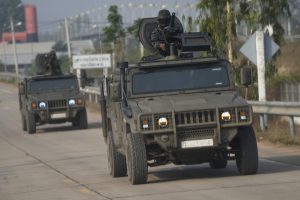Recent developments along the Thai-Myanmar border could be another entry in the growing list of setbacks for Myanmar’s military junta and further complicate Thailand’s efforts to bolster regional stability. In mid-April, rebel forces captured an infantry battalion headquarters in Myawaddy, dealing a significant blow to the junta, which has struggled to regain the lost territory. The military eventually managed to recapture the headquarters, but may not have been able to do so without infighting between different rebel groups.
With the intensified fighting along its border, Thailand has become increasingly concerned about its national security. The Thai government previously had faith in the junta’s ability to defeat the rebel groups and maintain stability, but recent changes in the balance of power show that it must develop a new Myanmar policy that fully engages with all relevant parties and considers all contingencies.
Since the 2021 coup in Myanmar, the Thai government has engaged primarily with junta leadership, the State Administration Council (SAC). The Thai Foreign Ministry has justified these actions by arguing that it was less a matter of government preference than an attempt to pursue the most straightforward path to peace in Myanmar. By providing legitimacy to the SAC, the Thai government hoped that the political situation in Myanmar would stabilize, even at the expense of its democracy. While this choice may have made strategic sense for Thailand’s government at the time, the SAC’s recent battlefield difficulties show the need for a change in Thailand’s Myanmar policy.
Before the rebel assault on Myawaddy, the Thai government’s main conflict initiative had been to establish a humanitarian corridor through the Mae Sot-Myawaddy border crossing. This plan, unanimously endorsed by the foreign ministers of the Association of Southeast Asian Nations (ASEAN), was intended to provide food and medicine to about 20,000 internally displaced people along the corridor. Now, with increasing violence along the border raising the prospect of a significant influx of refugees, this policy is no longer a sufficient response to the humanitarian crisis in eastern Myanmar.
Despite acknowledging the severity of the border crisis, and making concerted efforts to refocus Thai foreign policy, Srettha Thavisin has not done enough as prime minister to proactively engage with all combatants in Myanmar. The Thai government has largely refused to communicate with local Myanmar opposition forces, whose regional influence would allow the Thai government to cooperate more effectively with rebel groups in peace efforts and provide humanitarian assistance to civilian populations. Representatives from Ethnic Resistance Organizations (EROs) and the National Unity Government (NUG) claim that the Thai government’s current plan of action will not effectively reach all impacted groups in the border region. This would leave the Thai government unable to fully identify and address local needs, and will result in continued unrest and humanitarian suffering along the border and the further weakening of Thailand’s sense of security.
In order to respond more effectively to the ongoing border crisis, Thailand should implement three key policy changes. First, the Thai Foreign Ministry needs to open robust lines of communication and forums for dialogue with border region EROs, particularly the NUG and the Karen National Union and its armed wing, the Karen National Liberation Army. Second, Thailand must develop contingency plans for all outcomes in the border conflict, including a junta victory, a rebel victory, or fractured territorial divide amongst several groups. These plans would ensure that Thailand is well prepared for any outcome and can quickly and effectively respond to all new developments.
Finally, Thailand must also push ASEAN to refine its Myanmar policy. ASEAN’s policy towards Myanmar has changed very little over the past three years, and it does not take into account changes in the balance of power. ASEAN’s policy, the Five-Point Consensus, calls for an immediate end to the violence in Myanmar and inclusive political dialogue, but there is no reason to believe that either side has any interest in putting down its weapons and coming to the negotiating table. ASEAN cannot continue to hope for a quick end to the conflict, and its policy must reflect this. ASEAN should stop pushing for a premature peace agreement in Myanmar and instead develop strategic and diplomatic relationships with opposition forces.
While the Thai Foreign Ministry has offered to serve as a mediator between the SAC and EROs along their border, such discussions are unlikely to go anywhere. Both sides seem unwilling to stop fighting, and it is difficult to imagine a political agreement that satisfies all parties, making Thai hopes for a quick end to the conflict in Myanmar unlikely. Instead, Thailand must seriously consider all possible outcomes for this conflict and drive ASEAN to do the same. Developing an effective solution that acknowledges the rebel groups’ interests will be challenging, but it is the only way to secure a lasting peace.

































